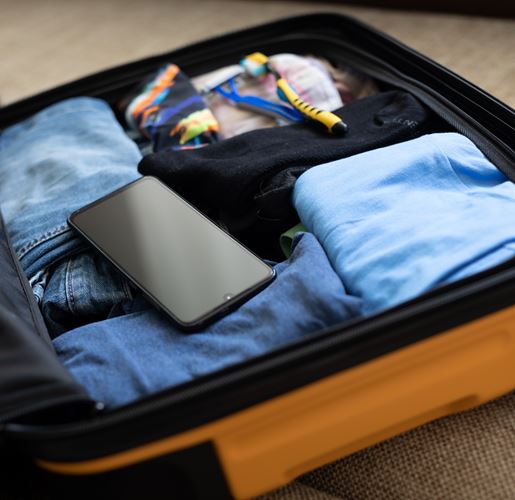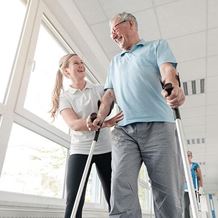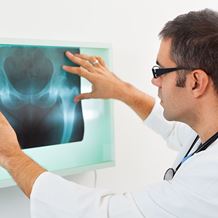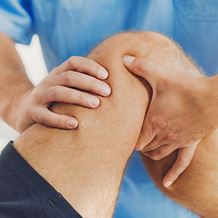Comfortable Adventures: How to Prevent Joint Pain When Travelling
- Home
- Services
- Orthopaedics
- Knowledge Hub
- Comfortable Adventures: How to Prevent Joint Pain When Travelling
Comfortable Adventures: How to Prevent Joint Pain When Travelling
Exploring new destinations and embarking on exciting journeys can be an incredible experience, but for many travellers, the adventure can come at a price — joint pain. Whether on a long-haul flight, navigating through new terrains or simply adjusting to different routines, the physical demands of travel can take a toll on your joints. This doesn’t mean you should avoid all the wonderful adventures the world has to offer — with the right information and preparation, you can turn the tables on travel-induced joint pain. We’ve pinpointed the medical reasons why your joints don’t feel so jolly while you travel, as well as the practical solutions to help prevent or alleviate joint discomfort.

Causes of joint pain while travelling
Like most ailments, experiencing joint pain can be tricky to alleviate if you’re not sure what’s causing it. We’ve rounded up some of the most common triggers for joint pain while travelling.
Prolonged sitting or inactivity
Long-haul transit usually means spending a lot of time seated. When you sit for long periods of time or remain inactive, the joints in your body may become stiff and less flexible. Lack of movement can result in several issues that contribute to aching joints, including:
- Reduced joint lubrication: Movement helps distribute synovial fluid, which lubricates and nourishes the joints. Prolonged inactivity can reduce the availability of this fluid, causing joint discomfort.
- Muscle weakness: Inactivity can cause the muscles that support your joints to weaken, leading to increased stress on the joints and potential pain.
- Reduced blood flow: Inactivity can slow blood circulation, depriving your joints of essential nutrients and oxygen.
- Joint compression: Long hours of sitting or inactivity can put pressure on specific joints, such as the hips and lower back, leading to pain and stiffness.
Overuse/overextension
“Overdoing it” can be a fast track to joint discomfort. Overusing a joint by subjecting it to repetitive movements or excessive stress can lead to wear and tear on the joint structures, potentially causing inflammation and pain.
Existing medical conditions
If you’re living with any of the following medical conditions, you may be more susceptible to joint pain while travelling.
- Arthritis: Osteoarthritis and rheumatoid arthritis can lead to increased joint pain and stiffness, which may be exacerbated by long periods of inactivity or changes in climate.
- Fibromyalgia: People with fibromyalgia often experience widespread muscle and joint pain, and the stress and discomfort associated with travel can intensify their symptoms.
- Gout: Travel, particularly if it involves dietary changes or alcohol consumption, can trigger gout attacks, leading to severe joint pain, most commonly in the big toe.
- Lupus: Systemic lupus erythematosus (SLE) can cause joint pain and swelling. The stress of travel can sometimes aggravate lupus symptoms.
Dehydration
It turns out that staying hydrated while you travel isn’t just good for your skin — it also gives your joints the fuel they need to operate properly. Dehydration can lead to a reduction in that all-important synovial fluid we mentioned earlier. Because this fluid is essential for reducing friction and ensuring smooth joint movement, a lack of it can cause stress on your joints. Additionally, dehydration can lead to muscular cramping and spasms, which can indirectly contribute to joint pain.

Joints susceptible to pain while travelling
So we've covered why you might be experiencing musculoskeletal pain while travelling, but it's important to know which joints are most likely to be affected by long-haul travel. Here are some of the joints that many people experience issues with.
Knees
Knee pain is a common affliction among Australians of all ages. Knee pain is a prevalent issue due to the complex structure and frequent use of the knee joint in daily activities — and because of our reliance on these joints, managing knee pain can be tough. Our knee joints support the body's weight, facilitate movement and absorb force during walking, running and other physical activities. Having your knees bent in a static seated position for an extended period is another major contributor to persistent knee pain.
Shoulders
Shoulder pain during travel can usually be attributed to posture, prolonged sitting and the type of luggage people carry. Many folks tend to slouch or adopt uncomfortable positions during extended periods of sitting — not to mention the seats on long-haul transit are generally not very supportive. The constrained space and lack of ergonomic support can strain the shoulder muscles and contribute to discomfort.
Spine
Many people suffer from back pain in day-to-day life, and long-haul travel can unfortunately make it worse. Prolonged periods of sitting (especially in confined spaces) can lead to poor posture and increased pressure on the spine. Insufficient lumbar support in vehicle seats or uncomfortable seating configurations can compound this discomfort. Lifting heavy luggage, awkward body positions during transit and the stress associated with travel can also strain the back muscles.


Hips
Hip pain during travel is a common issue due to a combination of factors related to prolonged periods of sitting and constrained movement. Limited legroom and inadequate support contribute to poor circulation and muscle tension. Additionally, immobility during travel can cause tightness in the hip flexors and hamstrings, exacerbating hip discomfort.
Hands and wrists
Hand and wrist pain is a common issue due to the intricate structure and constant use of these body parts in daily activities. The human hand is a complex assembly of bones, muscles, tendons and ligaments, finely tuned for precision and dexterity. When it comes to long-haul driving, those who experience hand and wrist pain may find it exacerbated by the repetitive nature of the activity.
How to prevent travel-related joint pain
Now that we’ve covered why travel can make your joints feel jarred, it’s time for some prevention strategies. Follow these tips to help reduce pain both during transit and while on your travels.
Make time for movement
What’s the antidote to inactivity? Movement! Try to stand up at least once an hour on long-haul transit to keep your blood flowing. When confined to a seat, you can perform discreet stretches and exercises to alleviate joint stiffness and promote circulation. Try ankle circles, gently rotating your ankles clockwise and counterclockwise. Knee-strengthening exercises like seated knee lifts, where you lift your knees one at a time toward your chest, can also help. Additionally, seated forward bends or gentle spinal twists can provide relief to your lower back and keep your joints mobile.

Be mindful of your luggage
Lugging around a large suitcase can cause some severe stress on your joints. If you don’t have someone to assist you, try to keep the contents of your suitcase on the lighter side. Seek help when moving luggage into overhead compartments, as this movement can put strain on critical joints. It’s also worth investing in sturdy, lightweight luggage with wheels — rolling instead of carrying is far less strenuous.
Increase your comfort
For many folks, travel means an increased step count and a lot of time on foot. Pack sturdy, supportive shoes that can absorb some of the strain that comes with this level of activity. If you’re going out and about for the day, take your essentials in a small bag — lugging around a large, overfilled backpack or shoulder bag can cause strain on your joints.
Top up that water bottle
As we mentioned earlier, dehydration can both cause and exacerbate joint pain. Keeping your water intake up on long journeys can curb some of the unpleasant side effects of dehydration. More water also means more excuses to get up and stretch, whether you’re headed for a refill or headed to the bathroom.
Schedule a stop
For some people, sitting in a plane or car for double-digit lengths of time can leave them in agony. If you know that long-haul travel is likely to cause some severe stress on your joints, consider adding a stop to your journey. Planning a flight with a layover or a road trip with a night’s stay can give you (and your joints) a chance to rest and recover.


Make a pain toolkit
Being prepared for a pain flare-up will help put your mind at ease. Assemble a toolkit with your go-to remedies and sources of relief — anti-inflammatory medications, compression gloves, topical creams, a knee brace, compression socks and stockings, heat and cold packs or anything else you typically rely on for help with chronic inflammation.
Don’t forget your medication
If you take medication for your joint health, make sure you’ve filled any scripts before your journey. Getting caught out without pain management or relief can be stressful! It’s also wise to ask your doctor or pharmacist for the names of generic equivalents of any brand-name medications that might not be available at your destination. It can also be tricky getting anti-inflammatory medication over the counter in some countries, so do some research and make sure you're stocked up before you go.
Get your driving ergonomics down pat
Heading on a road trip? To prevent joint pain while driving, it's crucial to maintain proper ergonomics. Here are some top tips for keeping your joints happy while behind the wheel:
- Adjust your seat and steering wheel for optimal comfort and posture.
- Take regular breaks to stretch your legs and change positions during long journeys.
- Do simple in-car exercises like ankle circles and seated leg lifts to keep your joints limber.
- Consider using supportive seat cushions or lumbar rolls to reduce pressure on your lower back and spine.
- Be mindful of your grip on the steering wheel to avoid wrist and hand strain. Cruise control is there to help you!
Get into relaxation mode
As exciting as travel is, it can also be stressful at times — and stress is something our joints don’t love. Even if you do everything “right”, you might still end up experiencing severe pain on your journey. If you’re feeling overwhelmed, frustrated or experiencing a pain flare-up, try your best to stay calm and practise some relaxation techniques. Deep breaths, mindfulness meditation and taking time out to rest are all quick ways to take some of the immediate pressure off.
With a bit of forward planning and a positive attitude, your next round of travel can be as pain-free as possible. Bon voyage!
Need a little extra help with your joint health? Take a look at St Vincent’s Orthopaedics services to find more information about solutions for your musculoskeletal issues.
This article contains information of a general nature, which may not be relevant to you. You should not rely on this article as medical advice. Any surgical or invasive procedure carries risk. We encourage you to speak with your doctor about your condition.



